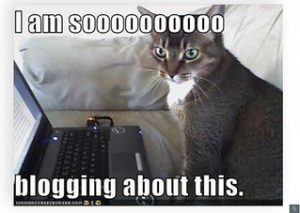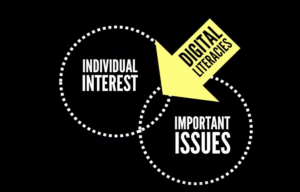
“Furry Influencers and Their Friends” by MSL Global is licensed under CC BY-SA 2.0
This week, we had a chat with Dr. Tim Winklemans, Graduation Lead for Graduation, Skills and Distance Learning for the BC Government and one of the minds behind BC’s Digital Literacy Framework. According to Winklemans, just over ten years ago, then BC Premier, Christy Clark, made a promise to ensure every student would be digitally literate at an early age. In order to sort out exactly what that meant, a working group convened and consulted with educators, trustees, and other people in the school system. Through their process, they identified the National Education Technology Standards Framework, a set of standards set out by the International Society for Technology in Education, or ISTE. In exploring the framework, they found it to be comprehensive and suitable as a starting point for BC. They also liked that it included supporting resources for educators. With a few adjustments, they incorporated the standards into BC’s Digital Literacy Framework. Somewhere along the way, the group expanded the scope of the project to include students from Kindergarten to Grade 12, rather than just learners at “an early age”. The final document also lists Common Sense Media’s K-12 Digital Literacy and Citizenship Curriculum and European Commission’s Online Consultation on Experts’ Views on Digital Competence as sources. Without the funding to widely promote and support the implementation of BC’s then new framework, it was published on the BC Government’s website.
The failure of the BC government to get behind BC’s Digital Literacy Framework and fund its promotion is perhaps the reason I had never seen it before the last summer. I have asked many teachers in my school if they know it and they do not. Ten years after its creation, it is now in need of updating. On the current Digital Literacy website, they appear to have taken some time to tie in BC’s Core Competencies but the document itself is missing some important elements. As Dr. Winklemans pointed out himself, it does not address principles of learning and worldviews of indigenous peoples. Also, he admits it does not specifically address inclusion and diversity. It mentions communicating through email, instant messaging, and video conferencing, but does not address popular social media such as Instagram, Snapchat, Tinder, Bumble, and TikTok.
After watching Doug Belshaw’s TEDx, I agree that there is a need to include a focus on students’ interests and the eight essential elements of digital literacies. With planned activities, appropriate cognitive, constructive, communicative, civic, creative, critical, confident, and cultural elements can be maximized. In Kindergarten and the primary grades, there will need to be room to learn the basic skills but then there needs to be plenty of time to play with technology. I am not talking about playing with educational games but they may play a role. I am talking about taking a photo and editing it with text and drawing tools, being silly on video, creating drawings with paint tools and stickers, animating play dough, telling stories, making puppet shows, taking pictures of clouds and adding audio or text about what they see, or goofing around in front of a green screen. If it is a job, children are nervous and shy, but if it is play, they can create great things! Play allows children to encounter the eight elements through exploration and experimentation which is certainly more intrinsically motivating than following a set of instructions to do a job for the teacher.
With regards to Belshaw’s criticism of linear frameworks, I can see a few points on the BC’s framework that can be introduced or modelled by the teacher earlier than the recommended grade. For example, a teacher can model increased accuracy in keyword searches; instead of having a video cued up and ready to show, the teacher can search for the video and show the children how to use details and the video filter. As another example, instead of reading a book about a subject, the teacher can search for and evaluate a variety of media in front of the class, explaining their thinking about which source to use. If we start talking about and modelling these skills in Kindergarten, they will be much less pixelated by the time they progress to grade three where the framework recommends they should be addressed.
I doubt anyone would deny that BC’s Digital Framework needs a refresh. The rapidly changing nature of technology demands that updates be more frequent than once in more than ten years. What would be more useful than a static document would be a more fluid resource in the form of a well maintained web page. But it seems that providing educators with a resource was not the goal so much as quietly voicing the opinion of the provincial government. Maybe someday, they will create an updated resource and back it up with some funding so that educators know it exists.
A Quick Blip About the Group Project
Our group includes Jeremy, Sean, Trevor, and me which puts us in the tricky position of trying to find a project that works for Kindergarten and high school woodshop and everything in between. We decided to create a project centred around How-to videos. Originally, we thought we would create a How-To How-To Video but with the spread of grade levels, we started talking about a web site or blog site. We created a Trello page for the group and have been brainstorming in a Google Doc. We’ve talked about what it might look like at each of our respective levels but we have not filled the spaces in between. Our ideations look like a jumbled mess right now but I am looking forward to figuring it all out and making something useful.

Great post! It is strange that this document was made and then “forgotten” about, or so it seems. I also had not heard of this until recently. With some updating and sharing with educators, this document could be a valuable tool!
It makes you wonder how effectively our tax revenues are being used when reports like this are commissioned and promptly tossed. Also of interest is how this framework was present while the province was moving to the “NEW” curriculum, yet almost none of it made it in.
Grievances aside, I think the majority of young children are fairly tech-savvy given that parents nowadays practically raise them on devices like tablets and smartphones. When I worked as a volunteer for Early Childhood Research at Science World, most of the participants who came in knew how interact with both analog and digital displays; those who didn’t were still able to quickly grasp skills like drawing on touchscreens. What I often seen lagging is the education around appropriate use of these technology, namely, when they should/shouldn’t have access to it. I’m curious about your opinion this matter: is there a certain grade where the focus shifts to focus on teaching digital citizenship versus digital literacy?
I don’t think there is a particular grade. I think it depends on the widely varying level of digital literacy in teachers. I’m not sure what happens in middle school but in elementary, there are still parents and teachers that actively avoid technology either because they don’t understand it or because they don’t believe in using it at this early level (except for a research project or a math program such as Reflex Math).
I too had not heard of the BC digital literacy until recently. Perhaps, with the online teaching most of us are doing now it will get some recognition. I’m not sure what it is like in elementary or middle schools but in the high schools there is a pressure to get technology and use it. It seems to be working well at my school as we get more and more chrome books and computers for students to use.
I hadn’t forgotten it. I was around when it was in the works & know Tim from my years in BCEd K12. It was actually cited by folks at UNESCO at one point as a promising emerging approach. I was sad to tell them it had been subsumed by the drive for the new curriculum.
I was unaware re. the under resourcing of this project–but another example of how BCEd or BC was in the lead–and it just wasn’t recognized as the promising practice it was or roll out was mangled ( e.g. BC Ed grad portfolios). I’m going to suggest “updating” this document as a project for some of my graduate diploma students this spring.